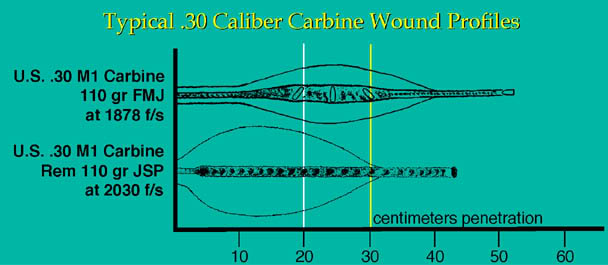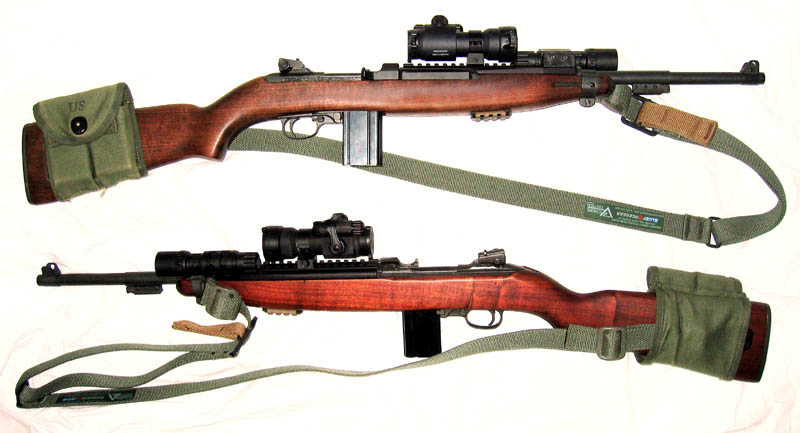-
Site Supporter

M1 Carbines
12/17/17
The .30 caliber M1 Carbine 110 gr FMJ military bullets have a typical velocity of 1970 f/s. As these are non-deforming, non-fragmenting projectiles, they produces minimal tissue damage, somewhat similar to the U. S. 9 mm NATO M882 124 gr FMJ. While M1 carbines have a poor reputation when using GI ball ammo, good expanding bullets offer a stunning leap in incapacitation potential and should cause us to rethink the M1 carbine as a self defense rifle in areas where more modern rifles are illogically prohibited and even as a LE patrol rifle for agencies that won’t allow AR15’s for whatever asinine reasons. The M1 Carbine is a very viable choice as a personal defense weapon for use out to 100 yards or so; in many ways, the M1 Carbine was the M4 of it's era (1940's to early 1960's) and can still be effective today when fed the right ammunition.

With expanding projectiles, the .30 caliber M1 Carbine creates a temporary cavity stretch that is slightly larger than that produced by heavy expanding .357 Magnum hunting loads and may be able to produce permanent splitting, tearing, and rupture injuries in tissues susceptible to stretch insults, such as the liver, kidney, spleen, pancreas, brain, and completely full fluid or gas filled hollow organs, such as the bladder. The best ammunition choices for the M1 Carbine are the Remington 110 gr JSP (R30CAR), Hornady 110 gr FTX, and loads using all copper Barnes X bullet 110 gr JHP (like the old Corbon DPX), and the outstanding Speer 110 gr Gold Dot (which sadly is no longer being made). The Remington load has an average velocity of 1864 f/s, expands to around .54” to .58” and penetrates 13” to 16” whether in bare gelatin, through automobile windshields, or Level IIIa body armor. This is comparable intermediate barrier performance to many good .223 loads. Likewise, typical loads using the Barnes 110 gr JHP penetrate 18.9" and expand to 0.56" in bare gelatin. The Winchester 110 gr JSP also works reasonably well, but has a bit smaller permanent wound channel compared to the Remington or Corbon DPX load. The Speer 110 gr Gold Dot carbine load was outstanding, as shown below:

Conversely, the Federal 110 gr JSP carbine bullet typically acts just like ball without any expansion. Hornady 90 gr JHP-XTP bullets offered insufficient penetration when fired from the carbine. When practicing, just use inexpensive non-corrosive FMJ, either from CMP or some other reasonably priced source.
Fulton Armory does an outstanding job on M1 Carbine re-builds and is highly recommended. To maximize the reliability of the M1 carbine, only use USGI weapons, as most commercial M1 Carbine clones have not proven as reliable as GI. It is a good idea to use an M2 mag catch, run a flip safety instead of the push button, and have a second head-spaced bolt ready for use, as this is a weak area. Oh...and make sure your gas piston nut is properly tightened and staked. Sights are typical military iron variety, although one can mount an optical sight with some difficulty. Accuracy is typically in the 3-4 MOA range, not great, but at least as good as the AK's. Typical reliability is around one easily cleared feeding failure per 500 or so rounds--no big deal. The M1 carbine stock has nearly perfect LOP as is, even with body armor on--I feel no need to try and add a collapsible stock to these weapons.
In general, avoid commercial magazines; GI 15 round mags typically are the most reliable, although some GI 30 rounders work ok...Wolff makes new mag springs that can help. The Black Hawk 2oz Duty Mace pouch (52DMP2BK) makes a very nice belt mag pouch for a M1 carbine 15 round magazine. 15 rd M1 carbine mags fit adequately into Paraclete triple flash bang pouches (BPP0707); the Paraclete flash light pouch (FLH0077) works OK to hold a single 30 round mag.
A simple way to attach accessories to get a small section of Pic Rail--we’ve used the long PRI ones installed on Mk12 Mod 0 SPR’s and then cut the rails to desired size with a hack saw (you can get 4 pieces out of the long PRI rail), smooth and polish the cuts with a file, Dremel Tool, and sand paper, then drill some holes in the rail piece and counter sink, spray the rail with flat black paint and let dry. Next drill some holes completely through your standard GI stock, use T-nuts and stainless steel bolts purchased at your local hardware store to fix the prepared Pic rail section to the stock. Attach the light of your choice--both the SF X300 and SF G2 work well.
Recently, the following modifications have improved the utility of M1 carbines for real world use:
-- Ultimak fore-ends
-- Aimpoint M3’s in Leup 30 mm med matte QRW rings or even better, T1’s in LaRue mounts.
-- SF 6v G2's in VTAC mounts
-- Blue Force Gear VCAS slings
-- London Bridge M1 carbine stock pouches

In general, the AR15 is a better choice for a patrol rifle or self-defense, as it is more accurate, more ergonomic, still in current production, and there are more accessories available, however, if you live in an overly restrictive state, modified M1 Carbines with good ammo make useful PC alternatives to M4's and AK's.
Think of the M1 carbine as a 100 yard PDW; they are light, handy, and fun to shoot--sort of like an MP5.
Last edited by DocGKR; 02-25-2019 at 09:36 PM.
 Posting Permissions
Posting Permissions
- You may not post new threads
- You may not post replies
- You may not post attachments
- You may not edit your posts
-
Forum Rules






